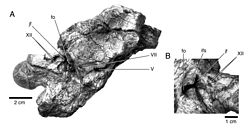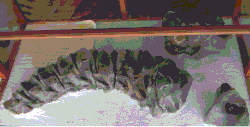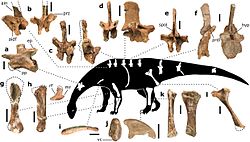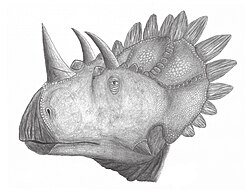| Name | Novelty | Status | Authors | Age | Unit | Location | Notes | Images |
|---|
Aegypius tugarinovi [71] | Sp. nov. | Valid | Manegold & Zelenkov | Early Pliocene, Ruscinian | |  Moldova Moldova
| An Old World vulture, Accipitridae, related to the cinereous vulture. | |
Alopecoenas norfolkensis [72] | Sp. nov | Valid | Forshaw | Holocene | |  Australia Australia
| A new scientific name for the Norfolk ground dove. The previous name used to refer to this species, Columba norfolciensis Latham (1801), was suppressed by ICZN in 2010. [73] |  |
Anas kurochkini [74] | Sp. nov. | Valid | Zelenkov & Panteleyev | Late Miocene | |  Russia Russia
| An Anatidae. | |
Archaeornithura [75] | Gen. et sp. nov. | Valid | Wang et al. | Hauterivian | Huajiying Formation |  China China
| A Hongshanornithidae. Type species A. meemannae. |  |
Athene inexpectata [76] | Sp. nov. | Valid | Pavia, Manegold, & Haarhoff | Early Pliocene | Varswater Formation |  South Africa South Africa
| A Strigidae | |
Circaetus haemusensis [77] | Sp. nov. | Valid | Boev | Early Pleistocene | |  Bulgaria Bulgaria
| A snake eagle | |
Cratoavis [78] | Gen. et sp. nov. | Valid | Carvalho et al. | Aptian | Crato Member, Santana Formation |  Brazil Brazil
| A member of Euenantiornithes of uncertain phylogenetic placement. [78] [79]
The type species is C. cearensis. |  |
Dunhuangia [80] | Gen. et sp. nov. | Valid | Wang et al. | Early Cretaceous | Xiagou Formation |  China China
| A member of Enantiornithes. The type species is D. cuii. | |
Eopachypteryx [81] | Gen. et sp. nov. | Valid | Mayr | Eocene | Messel Formation |  Germany Germany
| A bird of uncertain phylogenetic placement.
Type species E. praeterita. | |
Feitianius [82] | Gen. et sp. nov | Valid | O'Connor et al. | Early Cretaceous (Aptian) | Xiagou Formation |  China China
| A member of Enantiornithes. The type species is Feitianius paradisi. |  |
Foshanornis [83] | Gen. et sp. nov. | Valid | Zhao et al. | Early Eocene | Buxin Formation |  China China
| A bird of uncertain phylogenetic placement, possibly a relative of trogons. Type species F. songi. | |
Fumicollis [84] | Gen. et sp. nov. | Valid | Bell & Chiappe | Late Cretaceous (late Coniacian—early Campanian) | The Smoky Hill Member of the Niobrara Chalk |  United States United States
| A member of Hesperornithiformes. The type species is Fumicollis hoffmani. |  |
Gallinago azovica [74] | Sp. nov. | Valid | Zelenkov & Panteleyev | Middle Turolian | |  Russia Russia
| A snipe, Scolopacidae. | |
Hakawai [85] | Gen. et sp. nov. | Valid | De Pietri et al. | Early Miocene (19–16 Ma) | Bannockburn Formation |  New Zealand New Zealand
| A member of Scolopaci of uncertain phylogenetic placement. The type species is Hakawai melvillei. | |
Holbotia [86] | Gen. et sp. nov. | Valid | Zelenkov & Averianov | Early Cretaceous | |  Mongolia Mongolia
| A member of Enantiornithes, probably a relative of Gobipteryx . Type species H. ponomarenkoi. | |
Houornis [87] | Gen. et comb. nov. | Valid | Wang & Liu | Early Cretaceous | Jiufotang Formation |  China China
| A member of Enantiornithes of uncertain phylogenetic placement; a new genus for "Cathayornis" caudatus Hou (1997). | |
Hypsipetes cowlesi [88] | Sp. nov. | Valid | Hume | Holocene | |  Rodrigues Rodrigues
| A bulbul, Pycnonotidae | |
Juehuaornis [89] | Gen. et sp. nov. | Valid | Wang, Wang & Hu | Early Cretaceous | Jiufotang Formation |  China China
| A basal member of Ornithuromorpha. Type species J. zhangi. | |
Kuntur [90] | Gen. et sp. nov. | Valid | Stucchi et al. | Late Miocene | Pisco Formation |  Peru Peru
| A condor. Type species K. cardenasi. | |
Lavadytis [91] | Gen. et sp. nov. | Valid | Stidham & Hilton | Miocene (16.1–14.6 Ma) | |  United States United States
| A member of Anatidae; a member or a relative of members of the subfamily Oxyurinae. The type species is Lavadytis pyrenae. | |
Llallawavis [92] | Gen. et sp. nov | Valid | Degrange et al. | Late Pliocene | Playa Los Lobos Allo Formation |  Argentina Argentina
| A mesembriornithine phorusrhacid. Type species L. scagliai. |  |
Makahala [93] | Gen. et sp. nov. | Valid | Mayr | Latest Eocene or early Oligocene | Makah Formation |  United States United States
| A member of Procellariiformes. Type species M. mirae. | |
Mangystania [94] | Gen. et sp. nov | Valid | Zvonok, Zelenkov & Danilov | Eocene (Bartonian) | Shorym Formation |  Kazakhstan Kazakhstan
| Possibly a member of Suliformes. The type species is Mangystania humilicristata. | |
Miobaptus huzhiricus [95] | Sp. nov | Valid | Zelenkov | Miocene | |  Russia Russia
| A grebe | |
Mioporphyrula [96] | Gen. et comb. nov | Valid | Zelenkov in Zelenkov & Kurochkin | Late Miocene | |  Moldova Moldova
| A member of Rallidae. A new genus for "Tertiariaporphyrula" lungi Kurochkin & Ganea (1972). | |
Mwalau [97] | Gen. et sp. nov. | Valid | Worthy et al. | Holocene | |  Vanuatu Vanuatu
| A megapode. The type species is M. walterlinii. | |
Namapsitta [98] | Gen. et sp. nov. | Valid | Mourer-Chauviré, Pickford, & Senut | Middle Eocene | |  Namibia Namibia
| A Psittaciformes incertae sedis. Type species N. praeruptorum. | |
Nyctisoma [99] | Gen. et sp. nov. | Valid | Elżanowski & Zelenkov | Middle Miocene | Öoshin Formation |  Mongolia Mongolia
| An Ardeidae. Type species N. robusta. | |
Oligonomus [100] | Gen. et sp. nov. | Valid | De Pietri, Camens, & Worthy | Late Oligocene | |  Australia Australia
| A member of Charadriiformes related to the plains-wanderer. Type species O. milleri. | |
Opisthodactylus horacioperezi [101] | Sp. nov. | Valid | Agnolin & Chafrat | Early Miocene | Chichinales Formation |  Argentina Argentina
| A rheid ratite | |
Parapengornis [102] | Gen. et sp. nov. | Valid | Hu, O'Connor & Zhou | Early Cretaceous | Jiufotang Formation |  China China
| A member of Enantiornithes, a relative of Pengornis . Type species P. eurycaudatus. |  |
Patagorhacos [101] | Gen. et sp. nov. | Valid | Agnolin & Chafrat | Early Miocene | Chichinales Formation |  Argentina Argentina
| A member of Phorusrhacidae. Type species P. terrificus. | |
Petrosushkinia [96] | Nom. nov | Valid | Zelenkov in Zelenkov & Kurochkin | Late Miocene | |  Kazakhstan Kazakhstan
| A member of Falconidae. A replacement name for Sushkinia Tugarinov (1935) (preoccupied). | |
Porzana botunensis [103] | Sp. nov. | Valid | Boev | Early Pleistocene | |  Bulgaria Bulgaria
| A member of Rallidae, a species of crake. | |
Pterodroma imberi [104] | Sp. nov. | Valid | Tennyson, Cooper & Shepherd | Holocene | |  New Zealand New Zealand
| A member of Procellariidae, a species of gadfly petrel. | |
Pterygornis [105] | Gen. et sp. nov. | Valid | Wang, Hu & Li | Early Cretaceous | Jiufotang Formation |  China China
| A member of Enantiornithes. Type species P. dapingfangensis. | |
Rallus adolfocaesaris [106] | Sp. nov. | Valid | Alcover et al. | Holocene | |  Madeira (Porto Santo Island) Madeira (Porto Santo Island)
| A member of Rallidae, a species of Rallus | |
Rallus carvaoensis [106] | Sp. nov. | Valid | Alcover et al. | Holocene | |  Azores (São Miguel Island) Azores (São Miguel Island)
| A member of Rallidae, a species of Rallus | |
Rallus lowei [106] | Sp. nov. | Valid | Alcover et al. | Holocene | |  Madeira (Madeira Island) Madeira (Madeira Island)
| A member of Rallidae, a species of Rallus | |
Rallus minutus [106] | Sp. nov. | Junior homonym | Alcover et al. | Holocene | |  Azores (São Jorge Island) Azores (São Jorge Island)
| A member of Rallidae, a species of Rallus . The specific name is a junior homonym of Rallus minutus Pallas (1776), Rallus minutus Gmelin (1789) and Rallus minutus Forster (1844). Alcover et al. (2016) coined a replacement name Rallus nanus. [107] | |
Rallus montivagorum [106] | Sp. nov. | Valid | Alcover et al. | Holocene | |  Azores (Pico Island) Azores (Pico Island)
| A member of Rallidae, a species of Rallus | |
Rhamphastosula aguirrei [108] | Sp. nov. | Valid | Stucchi, Varas-Malca & Urbina-Schmitt | Miocene | Pisco Formation |  Peru Peru
| A member of Sulidae, a species of Rhamphastosula . |  |
Scolopax brachycarpa [109] | Sp. nov. | Valid | Takano & Steadman | Late Holocene | |  Haiti Haiti
| A woodcock. | |
Scopelortyx [98] | Gen. nov. et Sp. nov. | Valid | Mourer-Chauviré, Pickford, & Senut | Middle Eocene | |  Namibia Namibia
| A Paraortygidae, Galliformes. Type species S. klinghardtensis. | |
Shiriyanetta [110] | Gen. et sp. nov. | Valid | Watanabe & Matsuoka | Pleistocene | |  Japan Japan
| A duck. The type species is Shiriyanetta hasegawai. | |
Spheniscus anglicus [111] | Sp. nov. | Valid | Benson | Late Miocene | Bahía Inglesa Formation |  Chile Chile
| A banded penguin. |  |
Stemec [112] | Gen. et sp. nov. | Valid | Kaiser, Watanabe & Johns | Late Oligocene | Sooke Formation |  Canada Canada
| A member of Plotopteridae. The type species is Stemec suntokum. |  |
Sula brandi [108] | Sp. nov. | Valid | Stucchi, Varas-Malca & Urbina-Schmitt | Miocene | Pisco Formation |  Peru Peru
| A booby. |  |
Sula figueroae [108] | Sp. nov. | Valid | Stucchi, Varas-Malca & Urbina-Schmitt | Miocene | Pisco Formation |  Peru Peru
| A booby. |  |
Tyto cravesae [113] | Sp. nov. | Valid | Suárez & Olson | Quaternary (probably late Pleistocene) | |  Cuba Cuba
| A barn-owl, a species of Tyto . | |
Tyto richae [76] | Sp. nov | Valid | Pavia, Manegold, & Haarhoff | Early Pliocene | Varswater Formation |  South Africa South Africa
| A Tytonidae barn-owl. | |
Yuanjiawaornis [114] | Gen. et sp. nov. | Valid | Hu et al. | Early Cretaceous | Jiufotang Formation |  China China
| A member of Enantiornithes. Type species Yuanjiawaornis viriosus. | |















































